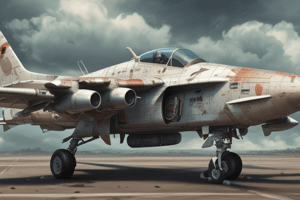Podcast
Questions and Answers
What is an indication of a wing-heavy condition in normal flight?
What is an indication of a wing-heavy condition in normal flight?
- The aircraft pitches up suddenly
- Less control wheel pressure is required to keep the wings level
- The aircraft rolls to one side
- Considerable control wheel pressure is required to keep the wings level (correct)
What is the purpose of rotating bushings (8) in the wing-heavy condition?
What is the purpose of rotating bushings (8) in the wing-heavy condition?
- To increase the angle-of-attack of the wing
- To decrease the angle-of-incidence of the wing
- To lower the leading edge of the wing
- To increase the angle-of-incidence of the wing (correct)
What is the first step to correct a wing-heavy condition?
What is the first step to correct a wing-heavy condition?
- Inspect the aileron for damage
- Remove wing fairing strip on the wing-heavy side of the airplane (correct)
- Tighten nut (10) and rotate bushings (8)
- Loosen nut (10) and rotate bushings (8)
What is the effect of rotating bushings (8) on the wing-heavy condition?
What is the effect of rotating bushings (8) on the wing-heavy condition?
Why is it necessary to loosen nut (10) before rotating bushings (8)?
Why is it necessary to loosen nut (10) before rotating bushings (8)?
What happens when the eccentric bushings are rotated separately?
What happens when the eccentric bushings are rotated separately?
What should you do if the wing-heavy condition still exists after the initial correction?
What should you do if the wing-heavy condition still exists after the initial correction?
What is the purpose of reinstalling the fairing strip?
What is the purpose of reinstalling the fairing strip?
What is the consequence of not correcting a wing-heavy condition?
What is the consequence of not correcting a wing-heavy condition?
What is the final step in the correction process?
What is the final step in the correction process?
Flashcards are hidden until you start studying
Study Notes
Identifying Wing-Heavy Condition
- A wing-heavy condition is present when considerable control wheel pressure is required to keep the wings level during normal flight.
Correcting Wing-Heavy Condition
- To correct the wing-heavy condition, two possible solutions can be applied:
Solution 1: Remove Wing Fairing Strip
- Remove the wing fairing strip on the wing-heavy side of the airplane to alleviate the condition.
Solution 2: Adjust Bushings
- Loosen nut (10) and rotate bushings (8) simultaneously until the bushings are positioned with the thick side of the eccentrics up.
- This adjustment lowers the trailing edge of the wing, decreasing wing-heaviness by increasing the angle-of-incidence of the wing.
Eccentric Bushing Alignment
- Rotating eccentric bushings simultaneously is crucial to maintain alignment between off-center bolt holes, preventing shearing force on the bolt and potential damage to the wing spar hole.
- Rotating bushings separately will destroy this alignment.
Correcting Wing-Heavy Condition
- If wing-heavy condition persists after initial setup, remove fairing strip on the lighter wing and loosen the nut.
- Rotate eccentric bushings simultaneously until the thick side of the eccentric is down, which raises the trailing edge of the wing and increases wing heaviness to balance the opposite wing.
Testing and Adjustment
- Perform a test flight to confirm wing-heavy condition correction.
- If necessary, repeat the process of loosening the nut, rotating the bushings, tightening the nut, and reinstalling the fairing strip until the wing-heavy condition is resolved.
Studying That Suits You
Use AI to generate personalized quizzes and flashcards to suit your learning preferences.




